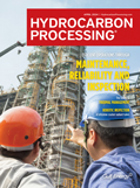Sulfur
Driving innovation in the downstream: IRPC returns to New Delhi
Gulf Publishing Company and Hydrocarbon Processing are pleased to announce that IRPC 2017 will be held April 18–20 in New Delhi.
Editorial Comment: Corrosion prevention starts at fabrication
Preventing corrosion begins with the choice of materials and methods used to fabricate the equipment, piping, valves and instruments that will be exposed to varying process conditions and weather. At present, designers and fabricators can select from a multitude of modern materials and methods. Once in service, effective asset integrity programs will use smart condition monitoring and, where needed, a treatment regime to sustain the useful working life of all components. In the Special Focus section of this issue, we provide several articles that illustrate good practices in vessel fabrication, corrosivity analysis and corrosion prevention treatment.
XOS launches sulfur, chlorine analyzer for petroleum refineries, labs
ALBANY, N.Y. -- XOS announced the release of Sindie +Cl, a sulfur and chlorine analyzer that delivers two critical measurements with one push of a button. It is the ideal for refineries and independent labs to certify sulfur levels in finished products and assess chlorine for corrosion mitigation.
Business Trends: Anticipated market and pricing impacts from new marine fuel regulations
In October 2016, the International Maritime Organization (IMO) announced that it will implement a new regulation that calls for the sulfur content in marine fuels to be reduced from 3.5% to 0.5%. The new regulation will go into effect in January 2020. This action by the IMO will have a profound impact on the maritime and refining industries worldwide, as well as on the environment. This month’s Business Trends section provides an overview on the anticipated impacts of the IMO’s decision on petroleum product markets.
Global: Is India ready for the BS-6 changeover?
India is the seventh-largest country in the world by land mass. Urbanization is taking place at a rapid pace: According to the country’s 2011 census, more than 377 MM Indians live in nearly 8,000 towns and cities. This count represents more than 31% of the country’s total population.
Put acid gas hydrocarbons in their place with staged regeneration
Common organic contaminants of Claus sulfur recovery unit (SRU) acid gas (AG) feed include: heavy hydrocarbons, in general; benzene, toluene, ethylbenzene and xylene (BTEX), in particular; and methanol (CH3OH).
Performance testing: The key to successful revamps
Process unit revamps often do not result in a refiner achieving its desired objectives. This is typically not the result of mechanical defects with process equipment.
Indonesia lowers sulfur content of subsidized diesel
SINGAPORE/JAKARTA (Reuters) -- Indonesia has lowered the sulfur content of its subsidized diesel in line with a global shift to move towards using cleaner fuel to curb pollution.
Business Trends: Global refining overview—Part 4
Throughout its overview series of the global refining industry, <i>Hydrocarbon Processing</i> has provided a look at the state of the refining industry, new project developments, demand outlooks for the refining sector and the move to low-sulfur fuels. The previous sections have taken a detailed look at the refining sectors of Asia-Pacific, North America and South America. This fourth and final installment analyzes major trends in Africa, Europe and the Middle East, and offers data on planned refinery capacity additions, upgrades and grassroots facilities.
Editorial Comment: Hydrocarbon Processing forecasts $321 B in total HPI spending in 2017
What is the state of the global hydrocarbon processing industry (HPI)? Which regions and sectors are seeing growth, and which are stagnant, or possibly shrinking? These were some of the questions that <i>Hydrocarbon Processing</i> editors tackled at the 43rd Annual <i>Hydrocarbon Processing</i> Forecast Breakfast.

- Shipping major and GCMD to pilot FAME-VLSFO marine biofuel bunker fuel in Singapore 5/9
- Diesel profit margins decline amid lower demand, more capacity 5/9
- World Energy and Boston Consulting Group sign agreement on SAF certificates 5/9
- Analysis: Chandra Asri purchase of Shell Singapore refinery brings scale, risk 5/9
- New $1.5-B natural gas pipeline to provide feedstock to Dow's petrochemicals plant and other industrial facilities 5/8
- Shell to sell interest in Singapore Energy and Chemicals Park to CAPGC 5/8




